R. Scot Johns's Blog, page 18
December 24, 2011
Kindle Updates
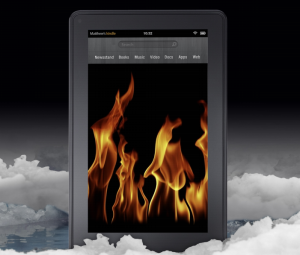
The Kindle Fire has been out for just five weeks now, and Amazon this week released its third firmware update, to version 6.2.1. As with the first two, this one installs automatically "over-the-air" while the Fire is asleep, so there's no need to install manually (although you can), nor do you need to "ok" the update: it rolls out whether you want it to or not as long as you're in wi-fi range.
It may seem unusual to update a product so often, and so soon, after its release, but I take this as a sign that Amazon is listening to customer feedback and working rapidly to effect repairs. That they want to continually improve the device rather than make their customers wait for next year's revision is a major benefit for users, who can purchase the Kindle knowing they'll receive continued product support. Unlike most hardware devices on the market today, the Kindle Fire is a continually improving machine, not just something you buy today and throw away tomorrow. The device I have today is better than the one I purchased last month, which is a trend I hope to see continue.
Improvement #1: UI
The primary focus of this latest update was to address issues with the user interface, from inconsistent touch response to the touchy carousel, and this is the first and most obvious fix this update has changed. The interface is much more smooth and consistent, and the carousel now stops much quicker on a chosen item, allowing it to be selected more easily. Before, the carousel moved so smoothly that it was difficult to stop, which often made for a frustrating experience. In addition, you can now remove items from the carousel by clicking and holding on its image.
Improvement #2: Password Lock
One of the complaints parents in particular have had is the inability to restrict access to Wi-Fi so as to keep young fingers from wandering where they ought not go (or buying what they shouldn't using one-click purchasing). This certainly makes sense for a multi-user household where children might use the device for reading and playing games, but in order for them to watch movies Wi-Fi would have to be turned on, since there's not enough memory to store more than one or two videos onboard.
Improvement #3: Browser/Streaming Performance
Which brings up the streaming/browser issue. I've only watched a few movies on the Fire just to check it out, and it's always worked flawlessly for me, so I can't quite understand the few complaints I've read of burps and glitches in the video, or slow browser performance. My guess is that the video glitches are due more to low Wi-Fi bandwidth, since to stream video smoothly on any device you need a 7 Mb or better connection, which many people don't yet have, and no hotels that I've stayed in. I have a 12Mb connection at home and the browser loads just fine. Side by side tests with my iPad 2 have had the Kindle Fire load pages faster than the iPad for sites I visit regularly, though not for others (and the 7" size is often an issue with selecting links). This tells me the "Silk" aspect of the Kindle browser is functioning just fine, anticipating my next move before I make it. The more you use the Silk browser, in fact, the faster it gets as it learns your preferences and pre-loads them for you behind the scenes. I suspect that users will begin to find it loading faster as time goes by, and will assume it's due to the firmware update. At any rate, this new update has supposedly improved video streaming performance for those who have had issues, but I can't corroborate that since I haven't had any myself.
Complaint #1: Rooting
The new update comes with one drawback for some users, which is that it undoes previous hacks that allow access to the Fire's inner workings, and prevents some of those hacks from being reintroduced. To me this is a completely bogus complaint, firstly because it only applies to a tiny fraction of Kindle Fire users, and secondly those users are trying to make the device into something it is not, and has never been intended to be. Amazon is selling a product with a given spec, openly divulging what the device contains and how it is intended to be used before you buy it. It is certainly the owner's right to modify a product they have purchased, but to expect the manufacturer to support those actions is ridiculous. If you want to remove the airbags from your car and turn it into a rally racer that's your business, but it voids the warranty and expunges the company of any responsibility for what occurs thereafter. If you want to root around in your device, then complain that Amazon's updates undermine your efforts to do so, then turn off your Wi-Fi and have at it; but you'll have to do so at the expense of all the other features that it offers, like Whispersync and Cloud storage, because Amazon only offers those under certain terms, and they say so right up front. It's the height of folly to think that Amazon's software engineers are going to work their updates around user hacks.
Kindle App Updates
Amazon also rolled out updates to the Kindle app for iOS this week, which includes Kindle Cloud access and Send-To-Kindle email function, support for the Kindle Fire's line of 400+ periodicals, as well as support for PDF and Kindle Print Replicas, which is Amazon's own PDF format, used primarily for textbooks with complex layouts. Unlike standard PDFs on Kindle devices, KPR allows you to annotate and highlight text just like any other Kindle book, as well as allowing them to be shared. All PDFs now have support for Table of Contents and Thumbnail browsing, as well as vastly improved page turn and render speed. Finally, a few new tabs in the main library screen allow you to isolate your personal Documents, Newsstand, or eBooks, as well as showing All Items as before.

Published on December 24, 2011 12:29
December 23, 2011
October Sales Figures Are In
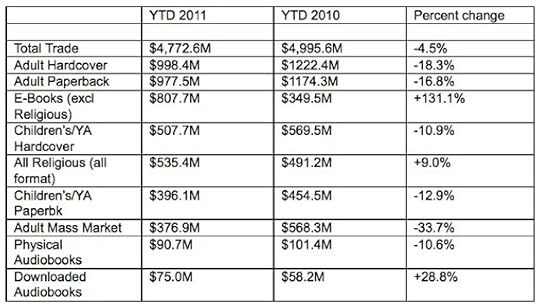
January-October Book Sales 2010 vs. 2011 [Credit: AAP via GalleyCat]
The AAP has just released updated sales figures for the publishing trade through October, which shows a continuing trend toward digital. While overall revenue is down slightly for the year (-4.5%), ebooks once again gave the strongest showing with an increase of 131% over the same period last year, while all print sectors were down (religious titles are not broken out between print and digital, so the ratio here is unknown). Digital audio downloads also posted a gain of 28.8%, while their equivalent physical editions fell by 10.6%.
For October alone, ebooks actually lost a bit of traction, showing only a "modest" +81.2% gain, their worst month this year, and the first drop below a 100% gain. For the record, here are the monthly gains for ebooks so far this year:
January: +115.8
February: +202.3
March: +145.7
April: +157.5
May: +146.9
June: +167
July: +105.3
August: +116.5
September: +100.9
October: +81.2
However, while digital continues to climb, it should be remembered that it still makes up a fraction of the overall book market, with all sectors still including in the single ebook figure while print is divided out among its several categories. The chart below gives a bigger picture of the current situation, showing ebook sales gaining rapidly, but as yet accounting for barely 20% of total sales. Still, it's the only one that's going up, and that's not likely to change for at least a few more years.
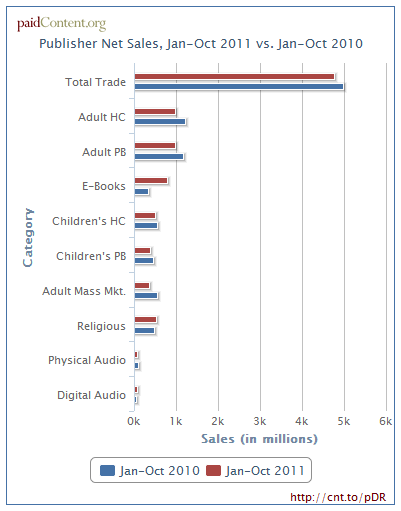
Total Sales Volume YTD 2010 vs. 2011 [Credit: paidContent.org]

Published on December 23, 2011 16:16
Charlie Brown Christmas Free eBook App
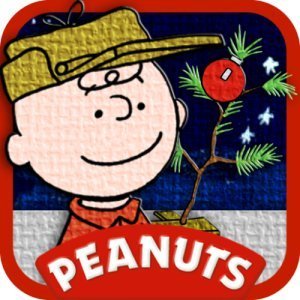
Click to get the app!
Today's free app for the Kindle Fire is a really fun and festive interactive ebook app that recreates the classic animated short as a digital pop-up book. The story is narrated by Peter Robbins, the voice of the original Charlie Brown character, with additional dialogue from the original TV feature. The digitally remastered illustrations appear as beautifully rendered pop-up cutouts, all of which can be interacted with in various ways to enhance the story, triggering character-specific dialogue and actions such as opening a mailbox or throwing down a megaphone.
Other features include a paint can that lets you finger paint on the screen, a lesson that teaches you to play Jingle Bells on Schroeder's piano, and a game in which you decorate a Christmas tree. Snowflakes can be caught and stars sent shooting across the sky with musical accompaniment. The final choral singalong allows you to add additional vocal notes by tapping each character, causing them to join in with the carol. Along the way there are twelve special ornaments to collect which are hidden among the scenes, with one being "unlocked" each day in a countdown to Christmas; collecting all of them rewards you with a "spectacular prize" at the end, and since there are only two days left till Christmas, all but one of the ornaments can now be found. We'll have to wait until tomorrow to find the last of them and discover what surprise is revealed.
The ebook app was created by Loud Crow, the makers of the award-winning PopOut! Tale of Peter Rabbit. Both for kids and kids-at-heart this richly illustrated storybook is sure to bring much joy and kindle inner warmth this Christmas season.

Published on December 23, 2011 09:33
December 22, 2011
Yellow Submarine Free Enhanced eBook
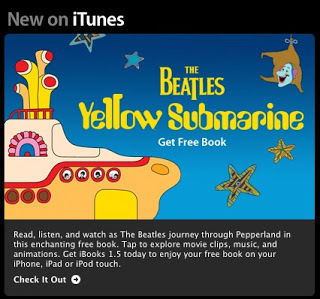
Click to get the free Yellow Submarine eBook!
With the release of iBooks 1.5 a few weeks ago iTunes released this new interactive ebook based on The Beatles' 1968 animated film Yellow Submarine (as a tribute to Steve Jobs, who was a Beatles fan). Anyone interested in enhanced ebooks should pick it up as it includes some really nice features that are now possible in iBooks editions, including animated graphics, touch interactivity that triggers various events, video clips from the film, a read-to-me audio track with shaped SVG text layers, and, of course, plenty of music.
And best of all, it's free!
Even if you're not a Beatles fan, it's still a pretty cool ebook to look at. It's a good example of how to integrate enhanced features to augment the story and create an immersive experience, rather than simply tacking on a couple of marginally related videos and calling it "enhanced". Of course, with Yellow Submarine having been an audio-visual experience in the first place, the content lends itself quite readily to this new medium. It's exciting to see that this sort of thing can now be done right in an ebook, without having to build a separate app. So I'm hopeful we'll be seeing a lot more books like this in the near future.

Published on December 22, 2011 14:14
December 19, 2011
50,000 Page Views

The technology on which I started writing my first book
I started writing this blog a little over three years ago as a way to document my experience in publishing a novel. Since then the publishing industry has changed dramatically in many unexpected ways, and so has this blog.
Originally I wrote a lot about how to set up your own publishing company in order to utilize the new Print On Demand model to produce print editions via Ingram's Lightning Source division, which enabled independent author-publishers to distribute to the two primary online retailers, Amazon and Barnes & Noble. At the time Amazon had only just released the first Kindle device, and while ebooks began to sell, print was still the only way to go. POD appeared to be the saving grace for independents, allowing them to produce professional quality books with little up front cost, and get them onto Amazon. As yet there were few tools available on Amazon to tweak your product page or understand your sales, and less on other sites, meaning that to a great degree self-pubbed authors were flying blind. There was no Smashwords, Barnes & Noble had yet to begin its PubIt program, and the iPad was just a dream in Apple's eye.
In October of 2008 The Saga of Beowulf was released via my fledgling publishing company Fantasy Castle Books, and that's when this blog began in earnest. But there was marketing to do if my novel was ever to be read, and so I spent a year discussing (and experimenting with) how to get your book in front of readers and reviewers, do blog tours and online interviews, and promote your work to the world at large. I built a website and starting adding content. I made promo videos, bookmarks, reference materials and a press kit. I posted sample chapters and audio excerpts, as well as my full screenplay on which the book was based. My book received two awards and sold steadily, if not dramatically. Facebook was only just taking over the reins of social network dominance from MySpace, and Twitter was as yet all but unknown to most. Smart phones had only recently come into their own.
Two years ago I started work on my next project, which was to be an original story I would post here on this blog as each writing session was done, which would allow for ongoing reader feedback during the writing process. But that took a sudden left turn when I was introduced to 3D digital art and decided to add full color illustrations to the new book. I had initially intended to add a lot of pen and ink art to that first book, but the sheer size and scope of the story ultimately prevented it: at 640 pages there just wasn't any room for pictures. But with this next project I would conceive it as a visual project from the start. And so I set off on another journey, learning 3D rendering with DAZ and Poser, and the book turned into something altogether more complex than I had planned. And thus another year went by.
Meanwhile, ebooks began to take over the market with a vengeance, altering the landscape of the publishing industry in near apocalyptic ways, with the shifting sands absorbing Borders and giving rise to the tablet market. Amazon has since become the go-to destination for independent authors, who now see ebooks as their savior, and the Kindle its figurehead via Kindle Direct Publishing. During the past year or so this blog has become a source for news and statistics on the digital "revolution," and my posts increasingly given to analyzing and evaluating the rapidly shifting terrain of both independent and traditional publishing. My particular focus has been on ways of reproducing illustrated books and graphic novels in the new e-media that has quickly flourished, since it was now certain that my new illustrated graphic novel project, The Ring Saga, would need to find a home on these new devices.
During the course of the past year I have posted - as I had originally planned to do - the pages of my latest work as they have progressed, both here and on my publisher website, with copious notes and additional images detailing my creative process. Since its inception this new project has consumed virtually every waking moment of my life that was not allotted to my day job, which still pays the vast majority of my bills. Surprisingly, just as this blog's readership has continued to climb, the sales of my first book have steadily increased as well, to the point where it brings in more income now than when I was heavily promoting it two to three years ago. This is almost entirely due to the increase in ebook sales, which now make up roughly 90% of my revenue.
It took over two years for this blog to hit 10,000 page views, which occurred December 29th last year. It's taken just under one year to add another 40,000 to that figure to quintuple my daily readership. I can only hope that means that what I write inspires and informs other authors, stimulates readers of epic and historical fantasy fiction, and instills an independent spirit into the creative writers and artists of tomorrow. Where this blog will go in the next three years is just as unknown as it was three years ago, but wherever that is, it's bound to be an adventure.
So thanks for reading, and stay tuned.
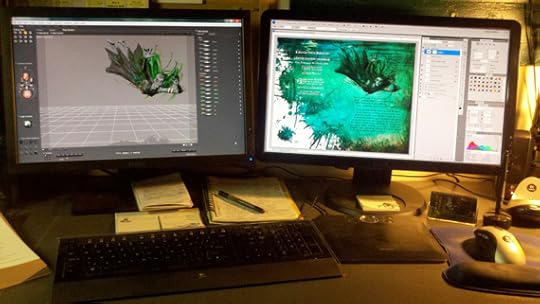
The technology on which I work now

Published on December 19, 2011 19:49
December 17, 2011
Aptara Survey Addendum - Enhanced Ebooks
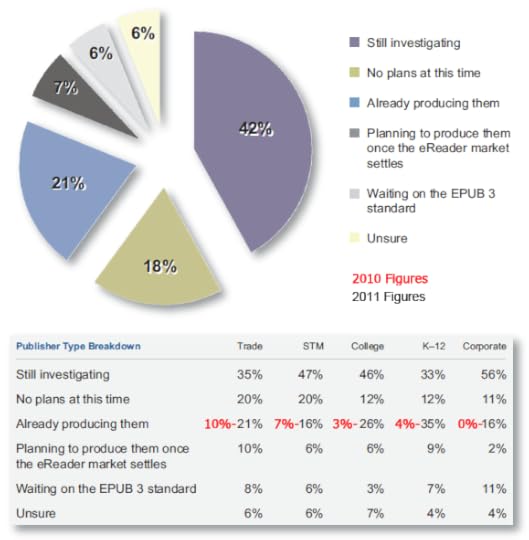
Breakdown of Enhanced eBook development among publishers
[Credit: Aptara Corp., "3rd Annual eBook Survey of Publishers," September 2011]
I meant to point this out the other day when I posted the Aptara survey infographic, but somehow missed adding it. This is just as well, as I feel it's significant enough to deserve a separate mention of its own. At least to those of us who are working to create graphic novels and stories with interactive elements that push the boundaries of what a book has been.
Ebooks have come a long way in a few short years, but one of the areas where they haven't even begun to reach their full potential is with regards to enhanced content. Aside from the sheer newness of the medium for many publishers, one of the main reasons for this is because thus far the major focus has been in converting print books to digital, in essence creating digital equivalents of printed books. Consequently, the major effort has been to develop digital editions that resemble print, that replicate printed books in electronic form, right down to the fake book edges and page turns found in iBooks.
While this is perfectly fine, particularly in converting previously published works, and has greatly helped to ease what has often been a difficult transition for many readers, it has at the same time limited the creative vision of what an electronic book can do going forward. Only now are content creators beginning to throw off the shackles and blinders that have restricted their imagination. Beyond just adding in some bonus video and audio content, electronic formats are capable of transcending the parameters of what a book has been until now. In the future, books will encompass a much broader spectrum of media, including such possibilities as networked interactive input from globally located readers, or books without boundaries, literally, in which the pages might turn in any direction, rather than just left to right, depending on where the reader wants the story to go. Adding factors such as geolocation and algorithmic adaptation can produce books that are different for each reader (or group of readers) each time they are read. The possibilities are virtually endless.
But first you must start somewhere. And for now, that's mainly been restricted to adding in some audio content and a couple of videos in between the standard lines of text. Cookbooks, travel guides, and other non-fiction works are the main place this is happening, aside from read-to-me features of children's books and a handful of pretty cool digital adaptations of classics such as Bram Stoker's Dracula, H.G. Wells' War of the Worlds, and a couple of rather curious Alice in Wonderland innovations. Most of these have been done as apps because ebook formats themselves haven't had the capability to produce them ... until now. With ePub 3 (and presumably KF8 to an as-yet unknown degree), the underlying HTML5/CSS3 coding incorporates the needed features of multi-layer, graphic intensive projects that enhanced ebooks inevitably entail, giving ebooks at last the possibilities of scripted content that websites have long had.
But one thing at a time. The chart above is taken from the recent Aptara survey discussed a few posts ago, and shows the rate of enhanced ebook development among the various publishing sectors. The key factor is the percentage of publishers who are now producing them, to which I have added (in red) last year's figures for reference. As you can see, the highest rate of production is in the education field, with K-12 publishers shifting in a single year from 4% to a 35% rate of adoption. This is likely due to the read-to-me feature and simple graphic interactivity being naturally suited to children's picture books such as those by Dr. Seuss, although more complex textbooks and scientific manuals have increased in production by quite a large margin as well. The Trade sector, which a year ago led the pack at 10%, has in the meantime fallen behind in its adoption rate, merely doubling its pace to 21%.
Overall, a whopping 42% of publishers say they're still investigating enhanced ebooks, with another 18% having no plans at all to begin producing them. Certainly, a large number of publishers never will, as the content they produce is not conducive to much more than basic black on white (although such enhancements as video interviews or embedded audio tracks for the visually impaired could be useful anywhere - and technically even hyperlinks and built in dictionaries are enhanced features not found in print editions, but who's counting?). A majority of the market will likely remain books built out of words and nothing more, at least for a time. But for those of us looking to develop extra features for our stories and bridge the gap between a broad array of multimedia experiences, these numbers are indicative of the state we're in: a tentative beginning in which only the first few steps have yet been taken.

Published on December 17, 2011 19:52
Amazon Adds US Reviews to UK Site

I'm not sure how long this has been active, but I just noticed that Amazon.co.uk has added a new function which imports reviews from the U.S. site to the respective U.K. and Canadian pages. The reviews are clearly marked as being derived from the U.S. market, and as you can see the feature is also marked as still in beta testing. This is a major update that I've been wanting to see for some time, as buyers from across the globe should be able to read reviews of a product they are considering, regardless of where those reviews originate. So kudos to Amazon for that. Only the top three most helpful reviews are shown, with a link beneath that takes you to the U.S. site to see the rest. In addition, only reviews from the U.S. site are imported. My one review on Amazon's Canadian page, for example, has not been imported elsewhere, while the U.S. reviews are now available there (although the Canadian review has only one helpful vote, so that may have ruled it out, since the lowest of the others has four). For titles that have more than three reviews on the native site already, there is just a link beneath to see U.S. reviews.

Another web page module imported to the U.K. is the "Popular Highlights" section, which allows Kindle ebook readers to make their highlights public, so that other Kindle readers with this function turned on can see them. This feature only shows up on a title's ebook listing (not on the print edition listing), and shows the most highlighted passage among Kindle readers who use the Public Notes feature. Unlike the reviews feature, this one has been rolled out everywhere except Japan (although I can't be sure, as I don't read Japanese), with the passage shown in English and the title and number of highlighters given in the site's native language.
The highlight shown above is from The Saga of Beowulf, and is my rendition of a passage from the Elder Edda Hávamál, which contains a list of old Nordic wisdom in the form of cryptic sayings (sort of like their version of fortune cookie quotes). I reworked a number of these and put them in the mouth of my wise old man Ægnir, who says little and always speaks in riddles, and apparently this is the one that readers liked the most. I guess a lot of people must lay awake and worry these days. Some things never change.

Published on December 17, 2011 14:19
December 16, 2011
Flex Lighting Demo
Flex Lighting is an LED sheet just 50 microns thin that can be used on eInk touchscreens to provide even lighting across the full display, allowing you to read in the dark. Unfortunately it's not an add-on product (yet), but look for these to be integrated into the next generation of eInk readers. No info is provided as to battery consumption, but since you can turn the light layer on and off it should be fairly low overall. If it works well (and is cost effective) this, combined with color eInk/Mirasol displays, could render LCD screens obsolete.



Published on December 16, 2011 06:37
December 15, 2011
Kindle Sales Figures Update

Amazon announced today that the Kindle line has been selling more than 1 million units per week for the past three weeks, with the Fire leading the charge as the best selling of the bunch. In addition, the press release states that the Kindle Fire has been the number one product across all of Amazon for the full 11 weeks it's been available to order. As usual, no specific breakdown of numbers was forthcoming, but this alone is more than Amazon generally reveals, and pegs the Fire at somewhere above a quarter million sales per week, with "demand accelerating" according to the release.
In a related report, Goldman Sachs projects that Amazon could sell as many as 6 million Fire tablets by year's end, plus another 8 million of the other Kindle models for a total of 14 million units sold in the final three months of 2011. The report goes on to predict between 15.5 and 20.5 million Kindle Fire devices will be sold in its first year of life. Meanwhile, a Morgan Stanley study projects 82 million iPads to sell next year, an increase in expectation of 42%. IDC reported some specific third quarter numbers that come close to, but don't quite jive with, those given in the earlier iSuppli report I commented on in a prior post, placing pre-Fire tablet sales in this order [iSuppli numbers given in brackets]:
Apple iPad 2 - 11.1 million for 61.5% of the market [11,123,000 / 69.7% market share]
Samsung Galaxy Tab - (+/-) 1 million for [1,250,000 / 7.8%]
HP Touchpad - 903,000 with 5% of the market (due to their $99 pre-Kindle Fire "fire sale") [not included in iSuppli figures, possibly due to the Touchpad being cancelled]
Barnes & Noble Nook(s) - 805,000 for 4.5% [750,000 / 4.7%]
Asus - 4% share, no unit figures given [presumably included in iSuppli 4.3% "Others" category, but not specified]
HTC - [not included here, but inexplicably given 5th place above Asus by iSuppli with 253,000 units sold and just 1.6% of the market]
Amazon has, of course, completely altered these figures for the final quarter of the year by taking second place with an estimated 14% market grab in just a matter of a few short weeks. This just goes to show how uncertain and unstable the tablet market is right now. The only thing that can be said for sure is that the market is growing at a rapid rate (IDC projects worldwide tablet sales for 2011 to reach 63.3 million), and who is doing well at any given point is - literally - up for grabs.

Published on December 15, 2011 18:14
December 13, 2011
Long Live The Independent Revolution!
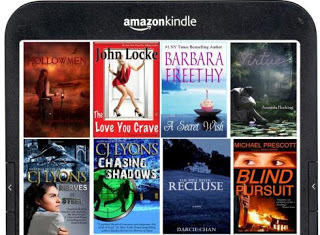
In case you missed it, USA Today did a feature this morning on how self-published authors are finding success, focusing on a half dozen specifically whose success stories are outlined. This is significant in that it brings news of the burgeoning independent movement to a mainstream readership, helping to legitimize the self-pub initiative and lay to rest the hackneyed and derogatory term "vanity press" with its outdated view of non-traditional publications as inherently worthless. As if it's somehow less effort to write an unsold novel than a million seller, or less admirable a struggle to fill 300 sheets of paper with words no one will ever read than to craft yet another story about a serial killer on the loose that is bound to sell because every other one just like it did.
I don't subscribe to USA Today, but I happened to be out of town and staying at a hotel when I had the latest issue laid in front of me at breakfast today. Needless to say it was a pleasant surprise, and welcome reading to see hard working authors (even of the serial killer variety) merit some well earned recognition, and the entrenched megalith that is traditional New York publishing receive an open challenge to its standard practice of deciding for the rest of us what we should be reading. By removing the middlemen who until now have been acting as our literary gatekeepers we, the readers, have been freed to decide for ourselves what merits our attention. In nearly every case mentioned in the story the powers-that-be completely missed what the readers understood by instinct: that a good story with interesting characters was lying in wait among those pages - pages which every agent and editor who "read" them consigned to the round file of oblivion, but which the readers then went on to buy in droves.
The great irony of this is that we live in a land and time where every voice is endowed by law and honor with the right to speak and be heard. And yet it has become all but impossible for the vast majority of authors to reach their destined readers. Only the chosen few are allowed to speak. The days when every pamphlet and treatise went to press regardless of how unorthodox or revolutionary are far behind us. The days of independent presses cranking out a stream of radical and even incendiary literature have been quelled by the pressure to deliver profits to faceless stockholders.
For too long has freedom of speech been hijacked by boardroom economics!
Too long have those with voices been silenced by corporate greed!
Too often are the needs of the many overridden by the interests of the few!
Too many are the pens laid to rest when their flow of words is staunched by form rejection letters!
But no more! The revolution has returned. Viva la ebook!
Long live true freedom of the press!

Published on December 13, 2011 22:17



